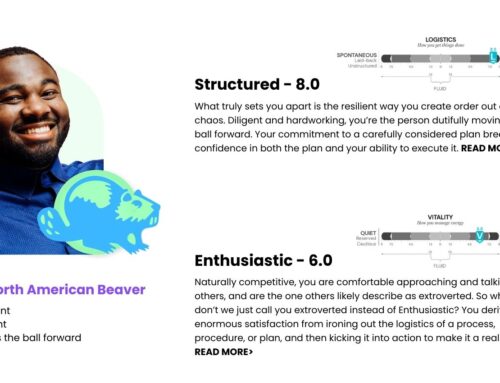Why You Should Forget Everything You’ve Read About Success
Articles about success often emphasize the individual. The person on the cover of the magazine. But ask those who have succeeded in business to explain the secrets to their success and almost always you’ll hear some variation of: “I was lucky enough to have some good people with me.”
Good people. Talented people. People who have your back. People you can trust to get the work done. People who lift your spirits when you’re down.
Notice a pattern? Successful people are surrounded by people with ‘the right stuff.’
Finding the Right Personalities
But if finding people with the ‘right stuff’ to surround yourself with is that important to success, why leave that part of the process to chance? Why not set out to find the right people before you even get started? And more important, how do you do that?
You need a way to adequately assess what ‘stuff’ they have. And personality is one critical ingredient to start with. The better your understanding of someone’s personality, the greater your ability to understand and work with that person (or, for that matter, date, raise, live near, etc.).
But it’s a bit more complicated than that. We’re talking about humans, after all.
Any human enterprise – business, family, friendship, marriage – represents a kind of personality equation. Meaning that if one personality is comprised of varying degrees of traits and sub-traits, then multiple personalities is a confluence of even more traits and sub-traits.
Picture a game of chess. Each time you move a piece, the number of possible games that can evolve from those initial moves grows – a lot. For example, by the time each player has made just five moves, the number of possible games numbers 69,352,859,712,417.
So, yeah, there are lots of possible outcomes when you combine two people and their various personality traits and sub-traits. Now picture a business of 10, or 50, or 500 employees.
Knowing Me, Knowing You
Fortunately, there’s a way to streamline some of this process in three relatively straight-forward steps.
- Know Yourself – If you don’t know yourself then any assumptions made about others is also suspect. So step 1 is to assess your own personality.
- Understand Others – When you’re assembling your team, be it for a startup or an internal project, ensure you understand something about the personalities of those you are considering.
- Use the ‘Right Tool’ – Start with the Top Personality Trait report, because is helps you understand your and others most dominant trait so you’ll have a solid sense of how team members will fare with each other.
Let’s say you’re looking to create a team of six people. You know you’re going to need a creative type who can brainstorm novel ideas quickly and efficiently. You also know you’ll need a couple of practical, nose-to-the-grindstone types who will get things done. You’re also going to want someone with some serious logistical chops for planning, keeping everyone on task and on budget. Lastly you’ll need a high-energy, fun-loving sales guy who’ll get out there and champion your product.
Solution: you take and give the Top Personality Trait assessment to everyone you’re considering for the team, then fill in the gaps from there. Remember, diverse teams outperform homogeneous ones.
While we’re not saying humans are like Legos you select by size and shape, we are saying that to succeed you need to ensure you’ve got the right people able to get the job done in the way you and your project need.
Don’t leave it to chance. Build your ‘dream team’ with people who really do have the ‘right stuff’ needed for productive teamwork, cohesion, morale and getting real results.
Why You Should Forget Everything You’ve Read About Success
Articles about success often emphasize the individual. The person on the cover of the magazine. But ask those who have succeeded in business to explain the secrets to their success and almost always you’ll hear some variation of: “I was lucky enough to have some good people with me.”
Good people. Talented people. People who have your back. People you can trust to get the work done. People who lift your spirits when you’re down.
Notice a pattern? Successful people are surrounded by people with ‘the right stuff.’
Finding the Right Personalities
But if finding people with the ‘right stuff’ to surround yourself with is that important to success, why leave that part of the process to chance? Why not set out to find the right people before you even get started? And more important, how do you do that?
You need a way to adequately assess what ‘stuff’ they have. And personality is one critical ingredient to start with. The better your understanding of someone’s personality, the greater your ability to understand and work with that person (or, for that matter, date, raise, live near, etc.).
But it’s a bit more complicated than that. We’re talking about humans, after all.
Any human enterprise – business, family, friendship, marriage – represents a kind of personality equation. Meaning that if one personality is comprised of varying degrees of traits and sub-traits, then multiple personalities is a confluence of even more traits and sub-traits.
Picture a game of chess. Each time you move a piece, the number of possible games that can evolve from those initial moves grows – a lot. For example, by the time each player has made just five moves, the number of possible games numbers 69,352,859,712,417.
So, yeah, there are lots of possible outcomes when you combine two people and their various personality traits and sub-traits. Now picture a business of 10, or 50, or 500 employees.
Knowing Me, Knowing You
Fortunately, there’s a way to streamline some of this process in three relatively straight-forward steps.
- Know Yourself – If you don’t know yourself then any assumptions made about others is also suspect. So step 1 is to assess your own personality.
- Understand Others – When you’re assembling your team, be it for a startup or an internal project, ensure you understand something about the personalities of those you are considering.
- Use the ‘Right Tool’ – Start with the Top Personality Trait report, because is helps you understand your and others most dominant trait so you’ll have a solid sense of how team members will fare with each other.
Let’s say you’re looking to create a team of six people. You know you’re going to need a creative type who can brainstorm novel ideas quickly and efficiently. You also know you’ll need a couple of practical, nose-to-the-grindstone types who will get things done. You’re also going to want someone with some serious logistical chops for planning, keeping everyone on task and on budget. Lastly you’ll need a high-energy, fun-loving sales guy who’ll get out there and champion your product.
Solution: you take and give the Top Personality Trait assessment to everyone you’re considering for the team, then fill in the gaps from there. Remember, diverse teams outperform homogeneous ones.
While we’re not saying humans are like Legos you select by size and shape, we are saying that to succeed you need to ensure you’ve got the right people able to get the job done in the way you and your project need.
Don’t leave it to chance. Build your ‘dream team’ with people who really do have the ‘right stuff’ needed for productive teamwork, cohesion, morale and getting real results.



